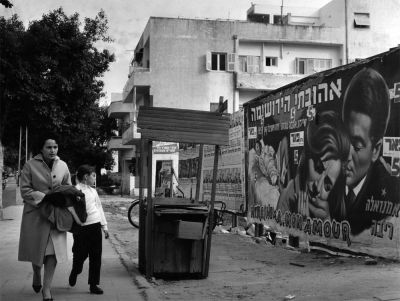
DESCRIPTION D’UN COMBAT
(Francia/1960) R.: Chris Marker. D.: 54’
T. int.: Description of a Struggle. Sog., Scen.: Chris Marker. F.: Ghislain Cloquet. M.: Eva Zora. Mus.: Lalan. Su.: SIMO. Int.: Jean Vilar (narratore). Prod.: Wim van Leer, SOPHAC. Pri. pro.: 27 aprile 1961 Digibeta. D.: 54'. Col. Versione francese / French version
Da: Israeli Film Archive - Jerusalem Cinémathèque
Chris Marker è un poeta del nostro tempo. Ha approssimativamente l'età della rolleiflex che porta intorno al collo. Non ha scritto poesie, non colleziona stati d'animo: viaggia. Vaga. Osserva. Forse guarda il mondo come altri si dedicano alla lettura: con passione e curiosità, saltando all'occasione qualche pagina, per poi ritornarci più tardi. Forse prende anche degli appunti, delle fotografie. Ma non è sicuro. In ogni caso, non è né un diario di bordo, né un quaderno di schizzi, né un album di fotografie quello che lui riporta dalle sue peregrinazioni, ma sono dei film (di lunghezza inusuale), o quest'oggetto bizzarro, Les Coréennes [libro di fotografie di Chris Marker, Seuil, Paris 1959], che sfida sia le leggi della scrittura (ma non nella misura che avrebbe voluto) sia quelle dei generi letterari. [...] In Lettre de Sibérie e in Description d'un combat le immagini vibrano come il timbro di una voce. E come non c'è voce senza timbro, non c'è, in Chris Marker, immagine (intendo dire, beninteso, l'immagine e il suo accompagnamento sonoro), dove non si avverta la personalità particolare del suo autore. Dipende dal fatto che ogni immagine di Description d'un combat è il racconto condensato, ellittico, di un'esperienza, di una presa di possesso del reale da parte di uno spirito e di una sensibilità che sono lo spirito e la sensibilità di Chris Marker. [...] Al fondo l'arte di Marker rassomiglia molto a quegli amalgami che in pittura si chiamano collage. Max Ernst diceva scherzando: "Se è la piuma che fa il piumaggio, non è la colla che fa il collage". Diciamo, parallelamente, che non è l'immagine che fa i film di Chris Marker. E neppure il commento. Ma senz'altro il montaggio di commento e immagine per il quale Bazin proponeva la definizione di montaggio orizzontale. Un montaggio estremamente originale, perché si manifesta al principio del film e non, come d'abitudine, nella sua fase conclusiva. È necessario precisare inoltre che non si tratta in questo caso di montaggio in senso tecnico (è evidente che dal punto di vista tecnico Marker deve necessariamente montare dopo le riprese e la trascrizione del commento), ma dell'attitudine umana di Marker di fronte alla realtà. Montare è, prima di ogni considerazione tecnica, un certo modo di vedere il mondo o, se si preferisce, di manifestarsi al mondo.
André S. Labarthe, Le Rolleiflex de Christophe Colomb, "Cahiers du cinéma", n. 122, agosto 1961
Chris Marker is a modern-day poet. He is about the same age as the rolleiflex he carries around his neck. He has not composed poetry, he is not a collector of moods: he travels. He wanders. He observes. Perhaps he sees the world the way other people read books: with passion and curiosity, sometimes skipping a few pages, to go back and read them later. Maybe he is taking notes with his photographs. But you can't be sure. In any case, they neither constitute a captain's log nor a sketch book nor an album of souvenir photos from his pilgrimages, but rather movies (albeit of a very unusual length). This bizarre object, Les Coréennes [photography book by Chris Marker, Seuil, Paris 1959], stretches the boundaries of writing (though not as much as he would have liked) and the definitions of literary genres [...]. In Lettre de Sibérie, in Description d'un combat, images vibrate like voices. And, just as every voice has its own timber, so each of Chris Marker's images (and by that of course I mean the images with their audio accompaniment), emanates with his particular vibration. Each image of Description d'un combat is a condensed, elliptical tale of an experience; a taking possession of reality by that unique spirit and sensitivity that is Chris Marker. [...] All in all, Marker's art resembles that synthesis of images that in painting is known as collage. As Max Ernst ironically said, "If the feathers make the plumage, it is not the glue that makes the collage". Similarly, we can say: it is not the images that make a Chris Marker film. Nor is it the commentary. But it is the editing of the commentary together with the images, for which Bazin coined the phrase horizontal editing. Such a technique is extremely novel, because it is imposed right from the start of the filmmaking process rather than, as is usually the case, as the final step. We need to emphasize that we are not speaking of editing in terms of a strictly technical process (obviously Marker needed to technically edit his films after having filmed and commented on them), but rather as Marker's human response to reality. Editing is much more than just a technical aspect of the filmmaking process, it is first and foremost a reflection of how the director sees the world, or, if you prefer, how he expresses what he sees to the world.
André S. Labarthe, Le Rolleiflex de Christophe Colomb, "Cahiers du cinéma", n. 122, August 1961

Tariffe:

Numero posti: 144
Aria condizionata
Accesso e servizi per disabili
Il nostro cinema aderisce al circuito CinemAmico: è possibile utilizzare l’applicazione MovieReading® per i film di cui è prevista audiodescrizione e/o sottotitolazione sull'applicazione.
Tel. 0512195311











